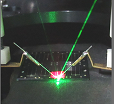InformationClose of Research Center for Photovoltaics (RCPV).2020.04.03
At the end of March, 2020, RCPVs 16-year history came to an end. - Web site of RCPV is still avalable here. |
| Research Teams/Groups |

|
Photovoltaic Device Team(Renewable Energy Research Center)Photovoltaic Power Team is developing technologies to fabricate highly efficient and reliable solar cells/modules. |

|
Photovoltaic System and Application Team(Renewable Energy Research Center)PV System and Application Team (PVSAT) is only the team that considers PV system not to be a photovoltaic device but to be a power generation system. Our team’s research objective is to improve “PV system for the welfare of PV users” and “PV system as a player of energy infrastructure”. |

|
Photovoltaic Calibration, Standards and Measurement Team(Renewable Energy Research Center)We develop accurate photovoltaic (PV) performance characterization technologies and PV reference device calibration technologies, contributing to the improvement of international competitiveness and mass deployment of PV technologies through the establishment of international conformity of the calibration and measurement technologies. |

|
Multijunction PV Team(Global Zero Emission Research Center)Cost reduction and improved conversion efficiency are the most important issues facing the wide-scale deployment of solar photovoltaic systems. Although multijunction solar cells have the highest reported efficiencies and have been commercialized for space and concentrator applications, their use has not become widespread due to their high cost. Our objectives are to develop low-cost multijunction technologies and to create new markets by ultra-high conversion efficiency, light weight and flexible PV. |

|
Organic-inorganic Hybrid PV Team(Global Zero Emission Research Center)To realize the practical use of organic-based solar cells, it is necessary to further improve the efficiency and the lifetime. Regarding the new field of organic-inorganic hybrid perovskite solar cells, in particular, we are focusing on new fabrication techniques and engineering the interfacial processes to achieve high efficiency and durability. For high efficiency organic thin-film solar cells, we perform structure analysis and optimization of the bulk heterojunction. Furthermore, we are developing semitransparent flexible cells and sub-modules by printing process and their application to energy harvesting. |

|
Compound Thin-Film Materials Group(Research Institute for Energy Conservation)We reveal the essential mechanisms which lead high-efficiency solar cells and develop the advanced device processing technologies to overcome the difficulties, particularly for compound semiconductor thin-film solar cells, such as CIGS and other chalcogenide thin-film solar cells. We also introduce the developed technologies to industrial sectors, and contribute to the development of solar cell industries in Japan. |

|
Energy Electronics Group(Research Institute for Energy Conservation)We have been investigating CZTS (Cu2ZnSnS4) solar cells using earth abundant materials, and new chalcogenide materials for TW scale PV introduction. We are also developing various kinds of techniques for evaluating electronic properties especially using XPS, UPS, and IPES connected with UHV multi-chambers. |
| Services |
| Links |
